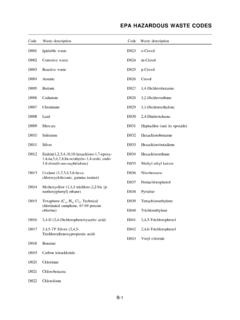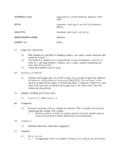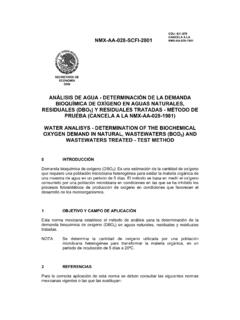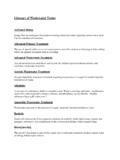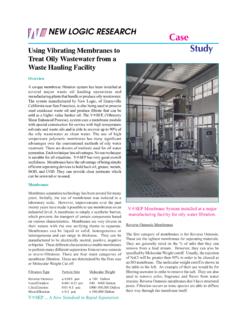Transcription of General Permit for Discharge of Stormwater and - …
1 BMMCA Rev. 8/21/13 DEEP-WPED-GP-015 1 of 45 General Permit for the Discharge of Stormwater and Dewatering Wastewaters from Construction Activities Issuance Date: August 21, 2013 Effective Date: October 1, 2013 Printed on recycled paper 79 Elm Street Hartford, CT 06106-5127 Affirmative Action/Equal Opportunity Employer BMMCA Rev. 8/21/13 DEEP-WPED-GP-015 2 of 45 General Permit for Discharge of Stormwater and Dewatering Wastewaters from Construction Activities Table of Contents Section 1. Authority .. 4 Section 2. Definitions .. 4 Section 3. Authorization Under This General Permit .. 9 (a) Eligible Activities .. 9 (b) Requirements for Authorization .. 9 (c) Registration .. 15 (d) Small Construction .. 17 (e) Geographic Area .. 17 (f) Effective Date and Expiration Date of this General Permit .. 17 (g) Effective Date of Authorization.
2 17 (h) Revocation of an Individual Permit .. 18 (i) Issuance of an Individual Permit .. 18 Section 4. Registration Requirements .. 18 (a) Who Must File a Registration .. 18 (b) Scope of Registration .. 18 (c) Contents of Registration .. 18 (d) Where to File a Registration .. 23 (e) Availability of Registration and Plan .. 23 (f) Additional Information .. 24 (g) Additional Notification .. 24 (h) Action by Commissioner .. 24 (i) Transition to New General Permit .. 24 (j) Latest Date to Submit a Registration Under this General Permit .. 25 Section 5. Conditions of this General Permit .. 25 (a) Conditions Applicable to Certain Discharges .. 25 (b) Stormwater Pollution Control Plan .. 26 (c) Monitoring .. 38 (d) Reporting and Record Keeping 41 (e) Regulations of Connecticut State Agencies Incorporated into this General Permit .. 42 (f) Reliance on Registration.
3 42 (g) Duty to Correct and Report Violations .. 42 (h) Duty to Provide Information .. 42 (i) Certification of Documents .. 42 (j) Date of Filing .. 42 (k) False Statements .. 43 (l) Correction of Inaccuracies .. 43 (m) Transfer of Authorization .. 43 (n) Reopener .. 43 (o) Other Applicable Law .. 43 (p) Other Rights .. 43 Section 6. Termination Requirements .. 44 (a) Notice of Termination .. 44 BMMCA Rev. 8/21/13 DEEP-WPED-GP-015 3 of 45 (b) Termination Form .. 44 (c) Where to File a Termination Form .. 45 Section 7. Commissioner's Powers .. 45 (a) Abatement of Violations .. 45 (b) General Permit Revocation, Suspension, or Modification .. 45 (c) Filing of an Individual Application .. 45 Appendix A Endangered and Threatened Species Appendix B Low Impact Development Guidance Information and Fact Sheet Appendix C Aquifer Protection Guidance Information Appendix D Coastal Management Act Determination Form Appendix E Conservation Districts of Connecticut Appendix F Memorandum of Agreement Between DEEP and Conservation Districts Appendix G Historic Preservation Review Appendix H Wild & Scenic Rivers Guidance BMMCA Rev.
4 8/21/13 DEEP-WPED-GP-015 4 of 45 General Permit for the Discharge of Stormwater and Dewatering Wastewaters from Construction Activities Section 1. Authority This General Permit is issued under the authority of section 22a-430b of the Connecticut General Statutes. Section 2. Definitions The definitions of terms used in this General Permit shall be the same as the definitions contained in section 22a-423 of the Connecticut General Statutes and section 22a-430-3(a) of the Regulations of Connecticut State Agencies. As used in this General Permit , the following definitions shall apply: x-year, 24-hour rainfall event means the maximum 24-hour precipitation event with a probable recurrence interval of once in the given number of years ( x=2, 25 or 100), as defined by the National Weather Service in Technical Paper Number 40, Rainfall Frequency Atlas of the United States, May 1961, and subsequent amendments, or equivalent regional or state rainfall probability information developed therefrom.
5 Annual sediment load means the total amount of sediment carried by Stormwater runoff on an annualized basis. Aquifer protection area means aquifer protection area as defined in section 22a-354h of the Connecticut General Statutes. Best engineering practices means the design of engineered control measures to control pollution to the maximum extent achievable using measures that are technologically available and economically practicable. CFR means the Code of Federal Regulations. Coastal area means coastal area as defined in section 22a-93(3) of the Connecticut General Statutes. Coastal waters means coastal waters as defined in section 22a-93(5) of the Connecticut General Statutes. Commissioner means commissioner as defined in section 22a-2(b) of the Connecticut General Statutes. Construction activity means any activity associated with construction at a site including, but not limited to, clearing and grubbing, grading, excavation, and dewatering.
6 Department means the Department of Energy & Environmental Protection. Developer means a person who or municipality which is responsible, either solely or partially through contract, for the design and construction of a project site. Dewatering wastewater means wastewater associated with the construction activity generated from the lowering of the groundwater table, the pumping of accumulated Stormwater or uncontaminated groundwater from an excavation, the pumping of surface water from a cofferdam, or pumping of other surface water that has been diverted into a construction site. District means a soil and water conservation district established pursuant to section 22a-315 of the Connecticut General Statutes. Appendix E lists the Districts, their geographic delineations, and contact information. BMMCA Rev. 8/21/13 DEEP-WPED-GP-015 5 of 45 Disturbance means the execution of any of the construction activity(ies) defined in this General Permit .
7 Effective Impervious Cover is the total area of a site with a Rational Method runoff coefficient of or greater (or other equivalent methodology) from which Stormwater discharges directly to a surface water or to a storm sewer system. Engineered Stormwater management system means any control measure and related appurtenances which requires engineering analysis and/or design by a professional engineer. Erosion means the detachment and movement of soil or rock fragments by water, wind, ice and gravity. Fresh-tidal wetland means a tidal wetland with an average salinity level of less than parts per thousand. Grab sample means an individual sample collected in less than fifteen minutes. Groundwater means those waters of the state that naturally exist or flow below the surface of the ground. Guidelines means the 2002 Connecticut Guidelines for Soil Erosion and Sediment Control, as amended, established pursuant to section 22a-328 of the Connecticut General Statutes.
8 High Quality Waters means those waters defined as high quality waters in the Connecticut Water Quality Standards published by the Department, as may be amended. Impaired water(s) means those surface waters of the state designated by the commissioner as impaired pursuant to Section 303(d) of the Clean Water Act and as identified in the most recent State of Connecticut Integrated Water Quality Report. In Responsible charge means professional experience for which the Commissioner determines that a professional s primary duties consistently involve a high level of responsibility and decision making in the planning and designing of engineered Stormwater management systems or in the planning and designing of soil erosion and sediment controls for residential and commercial construction projects. The Commissioner shall consider the following in determining whether a professional s experience qualifies as responsible charge experience: (i) the level of independent decision-making exercised; (ii) the number of individuals and the disciplines of the other professionals that the professional supervised or coordinated; (iii) the extent to which a professional s responsibilities consistently involved the review of work performed by other professionals involved the planning and designing of engineered Stormwater management systems or the planning and designing of soil erosion and sediment controls for residential and commercial construction projects.
9 (iv) the extent to which a professional s responsibilities consistently involved the planning and designing of engineered Stormwater management systems or the planning and designing of soil erosion and sediment controls for residential and commercial construction projects and whether such responsibilities were an integral and substantial component of the professional s position; (v) the nature of a professional s employer's primary business interests and the relation of those interests to planning and designing of engineered Stormwater management systems or to planning and designing of soil erosion and sediment controls for residential and commercial construction projects; BMMCA Rev. 8/21/13 DEEP-WPED-GP-015 6 of 45 (vi) the extent to which a professional has engaged in the evaluation and selection of scientific or technical methodologies for planning and designing of engineered Stormwater management systems or for planning and designing of soil erosion and sediment controls for residential and commercial construction projects; (vii) the extent to which a professional drew technical conclusions, made recommendations, and issued opinions based on the results of planning and designing of engineered Stormwater management systems or of planning and designing of soil erosion and sediment controls for residential and commercial construction projects; or (viii) any other factor that the Commissioner deems relevant.
10 Individual Permit means a Permit issued to a specific permittee under section 22a-430 of the Connecticut General Statutes. Inland wetland means wetlands as defined in section 22a-38 of the Connecticut General Statutes. Landscape Architect means a person with a currently effective license issued in accordance with chapter 396 of the Connecticut General Statutes. Linear Project includes the construction of roads, railways, bridges, bikeways, conduits, substructures, pipelines, sewer lines, towers, poles, cables, wires, connectors, switching, regulating and transforming equipment and associated ancillary facilities in a long, narrow area. Locally approvable project means a construction activity for which the registration is not for a municipal, state or federal project and is required to obtain municipal approval for the project. Locally exempt project means a construction activity for which the registration is for a project authorized under municipal, state or federal authority and may not be required to obtain municipal approval for the project.












